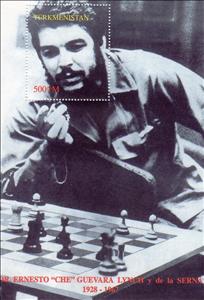Souvenir Sheet: Chess Ernesto Che Guevara Playing Chess (Turkmenistan 1997)
Chess Ernesto Che Guevara Playing Chess (Turkmenistan 1997)
01 January (Turkmenistan ) within release Chess (1997) goes into circulation Souvenir Sheet Chess Ernesto Che Guevara Playing Chess face value 500 Turkmenistani manat
| Souvenir Sheet Chess Ernesto Che Guevara Playing Chess in catalogues | |
|---|---|
| Colnect codes: | Col: TM 1997-06 |
Souvenir Sheet is square format.
This item has been denounced in Scott Catalog as illegally produced without the authorization of the postal administration. Beware This item found on fake FDC's with false cancels. Avoid! The fake FDC's do confirm with the false cancels that this item was made in 1997. Also some dealers are using false Yvert et Tellier catalog numbers. Avoid!Also in the issue Chess (1997):
- Souvenir Sheet - Chess Ernesto Che Guevara Playing Chess face value 500;
- Mini Sheet - Chess The History of Chess face value 4*195;
Souvenir Sheet Chess Ernesto Che Guevara Playing Chess it reflects the thematic directions:
Chess is usually played by two players (called chess players) against each other. It is also possible for one group of chess players to play against another or against one player; such games are often called consultation games. In addition, there is the practice of simultaneous play sessions, when several opponents play against one strong player, each on a separate board.
The rules of the game were basically developed by the 15th century; In modern official tournaments, the rules of the International Chess Federation[6] are applied, which regulate not only the movement of pieces, but also the rights of the judge, the rules of behavior of players and time control. A game played remotely - for example, by correspondence, by telephone or via the Internet - has special rules. There are many variants of chess that differ from classical ones: with non-standard rules, pieces, board sizes, etc. The corresponding section of chess composition is fairy chess. Some aspects of the game of chess are studied in mathematics (for example, the classic “Knight's Move Problem” and “Eight Queens Problem”), including through computer simulation. Chess is usually played by two players (called chess players) against each other. It is also possible for one group of chess players to play against another or against one player; such games are often called consultation games. In addition, there is the practice of simultaneous play sessions, when several opponents play against one strong player, each on a separate board.
The rules of the game were basically developed by the 15th century; In modern official tournaments, the rules of the International Chess Federation[6] are applied, which regulate not only the movement of pieces, but also the rights of the judge, the rules of behavior of players and time control. A game played remotely - for example, by correspondence, by telephone or via the Internet - has special rules. There are many variants of chess that differ from classical ones: with non-standard rules, pieces, board sizes, etc. The corresponding section of chess composition is fairy chess. Some aspects of the game of chess are studied in mathematics (for example, the classic “Knight's Move Problem” and “Eight Queens Problem”), including through computer simulation.
Famous People refers to the fame and public attention accorded by the mass media to individuals or groups or, occasionally, animals, but is usually applied to the persons or groups of people (celebrity couples, families, etc.) themselves who receive such a status of fame and attention. Celebrity status is often associated with wealth (commonly referred to as fame and fortune), while fame often provides opportunities to make money.


